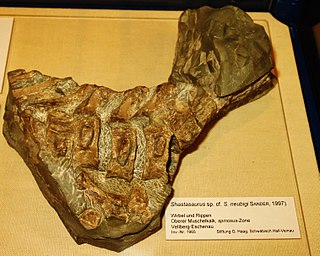
The occipital bone is a cranial dermal bone and the main bone of the occiput. It is trapezoidal in shape and curved on itself like a shallow dish. The occipital bone overlies the occipital lobes of the cerebrum. At the base of the skull in the occipital bone, there is a large oval opening called the foramen magnum, which allows the passage of the spinal cord.

Bauria is an extinct genus of the suborder Therocephalia that existed during the Early and Middle Triassic period, around 246-251 million years ago. It belonged to the family Bauriidae. Bauria was probably a herbivore or omnivore. It lived in South Africa, specifically in the Burgersdorp Formation in South Africa.

Anatosuchus is an extinct genus of notosuchian crocodyliforms discovered in Gadoufaoua, Niger, and described by a team of palaeontologists led by the American Paul Sereno in 2003, in the Journal of Vertebrate Paleontology. Its duck-like snout coincidentally makes it resemble a crocoduck, an imagined hybrid animal with the head of a crocodile and the body of a duck.

Lazarussuchus is an extinct genus of amphibious reptile, known from the Cenozoic of Europe. It is the youngest known member of Choristodera, an extinct order of aquatic reptiles that first appeared in the Middle Jurassic. Fossils have been found in Late Paleocene, Late Oligocene, Early Miocene and possibly Late Miocene deposits in France, Germany, and the Czech Republic. Two species have been named: the type species L. inexpectatus ("unexpected") from the late Oligocene of France. and L. dvoraki from the early Miocene of the Czech Republic. It was not a large animal; with the total preserved body and tail length of L. inexpectatus being just over 30 centimetres. A complete specimen of Lazarussuchus with preserved soft tissue was found from the Late Paleocene of France, but has not been assigned to a species.

Phantomosaurus is an extinct genus of ichthyosaur that lived during the late Anisian stage of the Middle Triassic. Fossils have been found in southern Germany. It was discovered in 1965 and named in 1997 as a species of Shastasaurus by Sander in the rocks of the Upper Muschelkalk.
Wabulacinus ridei lived during the early Miocene in Riversleigh. It is named after David Ride, who made the first revision of thylacinid fossils. The material was found in system C of the Camel Spurtum assembledge.

Khunnuchelys was a genus of trionychine turtle from the Late Cretaceous of Asia. Three species are known, K. erinhotensis, the type species, K. kizylkumensis, and K. lophorhothon. K. erinhotensis is known from the Iren Dabasu Formation in China from the late Turonian until the middle Campanian. K. kizylkumensis is known from the late Turonian Bissekty Formation of Uzbekistan. The third species, described in 2013 by Danilov et al., is known from the early to middle Campanian aged Bostobe Formation of Kazakhstan.
Metopocetus is an extinct genus of baleen whale belonging to the family Cetotheriidae. The type species is Metopocetus durinasus.

Otekaikea is an extinct genus of toothed whale closely related to Waipatia. It is known from the late Oligocene (Chattian) of New Zealand.

Tranatocetus is an extinct genus of mysticete from the late Miocene (Tortonian) of Jutland, Denmark. The type and only species is Tranatocetus argillarius.
Zarhinocetus is an extinct genus of whale from the Early to Middle Miocene of the eastern North Pacific.

Allodelphis is an extinct genus of whale belonging to Allodelphinidae found in marine deposits of the eastern North Pacific.
Allodelphinidae is a family of primitive platanistoid river dolphins found in marine deposits in the eastern North Pacific region, Alaska, and Japan.

Hoffstetterius is an extinct genus of toxodontid notoungulate mammal, belonging to the subfamily Toxodontinae whose remains were discovered in the Middle to Late Miocene Mauri Formation in the La Paz Department in Bolivia. The only described species is the type Hoffstetterius imperator.
Eodelphinus is an extinct genus of oceanic dolphins belonging to the family Delphinidae.
Macrosqualodelphis is an extinct genus of river dolphins from the Early Miocene (Burdigalian) Chilcatay Formation of the Pisco Basin, Peru. The type species is M. ukupachai.
Taikicetus is a genus of basal thalassothere baleen whale from the Middle Miocene of Japan.
Miobalaenoptera is an extinct genus of rorqual from the Late Miocene (Messinian) of Japan.
Diamantofelis is an extinct genus of felids that lived in what is now Namibia during the Early Miocene. It contains a single species, Diamantofelis ferox.
Namafelis is an extinct genus of felids that lived in what is now Namibia during the Early Miocene. It contains a single species, Namafelis minor. Closely related to Diamantofelis, it is of “Pseudaelurus-grade”, and therefore a rather basal member of the cat family.









